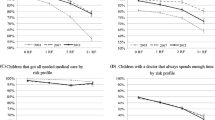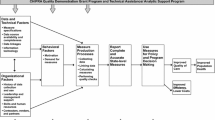Abstract
Objective: Children with chronic health conditions face special issues in their interactions with managed care. These children often require additional and more varied services than do other children. Managed care plans increasingly include these children, especially with the growth of Medicaid managed care. This article examines the special issues facing children with chronic conditions and develops strategies for monitoring their care in managed care settings. Methods: The project staff conducted an extensive review of the research and policy literature related to managed care and the special needs of families with children with chronic conditions. The project also reviewed current and proposed plans of federal, state, and private groups for monitoring and, working with parents and other outside groups, identified key issues to consider in developing monitoring plans. Results: The relative rarity of many childhood conditions and the complex interactions among child, family, and community over time make assessment of their care difficult. We describe these child and family characteristics, outline essential features and domains for monitoring systems, and describe population-based and plan-based monitoring systems to assess managed care for these children and their families. Conclusions: Monitoring for children with chronic conditions in managed care arrangements will require public health agencies and health providers to define populations systematically, assess across a variety of conditions, and monitor several domains central to the health of these families.
Similar content being viewed by others
REFERENCES
Freund DA, Lewit EM. Managed care for children and pregnant women: Promises and pitfalls. Futures Children 1993;3:92–122.
Association of State and Territorial Health Officials. Public health strategies for Medicaid managed care. ASTHO Access Rep 1995:1–8.
Jameson E, Wehr E. Drafting national health care reform legislation to protect the health interests of children. Stanford Law Policy Rev J 1993;5:1.
Perrin EC, Newacheck P, Pless IB, Drotar D, Gortmaker SL, Leventhal J, Perrin JM, Stein REK, Walker DK, Weitzman M. Issues involved in the definition and classification of chronic health conditions. Pediatrics 1993;91:787–93.
Newacheck PW, Hughes DC, Stoddard JJ, Halfon N. Children with chronic illness and Medicaid managed care. Pediatrics 1994;93:497–500.
Cook TD, Campbell DT. Quasi-experimentation: design and analysis issues for field settings. Chicago: Rand McNally, 1979.
National Committee for Quality Assurance. HEDIS 3.0. Washington, D.C., 1996.
Richmond JB, Walker DK, editors. Monitoring child health in the U.S.: Selected issues and policies. Cambridge, MA: Harvard University Press, 1984.
Newacheck P, Starfield B. Monitoring health care reform for children and families. In: Integrating federal statistics on children—report of a workshop. National Research Council, Institute of Medicine. Washington, D.C.: National Academy Press, 1995:156–91.
Aday L. Designing and conducting health surveys. San Francisco: Jossey-Bass, 1993.
Moore K. Children and families: Data needs in the next decade. Presented at the interagency Family Data Working Group Meeting, Washington, D.C., May 25, 1993.
Newacheck PW, Taylor WR. Childhood chronic illness: Prevalence, severity, and impact. Am J Public Health 1992;82:364–74.
Pless IB, Roghmann KJ. Chronic illness and its consequences: Observations based on three epidemiologic surveys. J Pediatrics 1971;79:351–59.
Gortmaker S, Sappenfield W. Chronic childhood disorders: Prevalence and impact. Pediatric Clin North Am 1984;31:3–18.
Stein RE, Bauman LJ, Westbrook LE, Coupey SM, Ireys HT. Framework for identifying children who have chronic conditions: The case for a new definition. J Pediatrics 1993;122:342–7.
Agency for Health Care Policy and Research. Report to Congress: The feasibility of linking research-related data bases to federal and non-federal medical administrative data bases. AHCPR Publication No. 91-0003. Rockville, MD, 1991.
Remington PL, Smith MY, Williamson DF, Anda RF, Gentry EM, Hogelin GC. Design, characteristics, and usefulness of state-based behavioral risk factor surveillance: 1981–1987. Public Health Rep 1988;103:366–75.
Donabedian A. Explorations in quality assessment and monitoring: Volume 1, the definition of quality and approaches to its assessment. Ann Arbor, MI: Health Administration Press, 1980.
Donabedian A. The end results of health care: Ernest Codman's contribution to quality assessment and beyond. Milbank Q 1989;67:233–56.
Valdez RB, Ware JE, Manning WG, Brook RH, Rogers WH, Goldberg GA, Newhouse JP. Prepaid group practice effects on the utilization of medical services and health outcomes for children. Pediatrics 1989;83:168–80.
Newacheck PW, Stein REK, Walker DK, Gortmaker SL, Kuhlthau K, Perrin JM. Monitoring and evaluating managed care for children with chronic illnesses and disabilities. Pediatrics 1996;98:952–8.
Starfield B, Bergner M, Ensminger M, Riley A, Ryan S, Green B, McGauhey P, Skinner A, Kim S. Adolescent health status measurement. Pediatrics 1993;91:430–5.
Breslau N, Mortimer EA. Seeing the same doctor: Determinants of satisfaction with specialty care for disabled children. Med Care 1981;19:741–58.
New England SERVE. Enhancing quality: Standards and indicators of quality care for children with special health care needs. Boston, MA, 1989.
National Association of Children's Hospitals and Related Institutions. Pediatric excellence in delivery systems. Alexandria, VA: NACHRI, 1995.
HA Grason B Guyer (1995) NoChapterTitle Public MCHprogram functions: Essential public health services to promote maternal and child health in America Child and Adolescent Health Policy Center, Johns Hopkins University Baltimore, MD
Grason HA, Guyer B. Public MCH program functions: Essential public health services to promote maternal and child health in America. Baltimore, MD: Child and Adolescent Health Policy Center, Johns Hopkins University, 1995.
Institute of Medicine. The future of public health. Washington, D.C.: National Academy Press, 1988.
Gortmaker SL, Perrin JM, Weitzman M, Homer CJ. An unexpected success story: Transition to adulthood of youth with chronic physical health conditions. J Res Adolescence 1993;3:317–36.
Author information
Authors and Affiliations
Rights and permissions
About this article
Cite this article
Perrin, J.M., Kuhlthau, K., Walker, D.K. et al. Monitoring Health Care for Children with Chronic Conditions in a Managed Care Environment. Matern Child Health J 1, 15–23 (1997). https://doi.org/10.1023/A:1026220201804
Issue Date:
DOI: https://doi.org/10.1023/A:1026220201804




